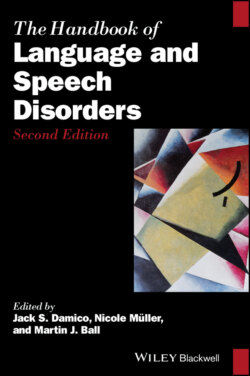Читать книгу The Handbook of Language and Speech Disorders - Группа авторов - Страница 60
4.2 Intelligibility Defined
ОглавлениеIntelligibility is a complex and multifaceted construct that is dynamic in nature. It has been defined as the extent to which an acoustic signal, generated by a speaker, can be correctly recovered by a listener (Kent, Kent, et al., 1989; Kent, Weismer, Kent, & Rosenbek, 1989; Yorkston & Beukelman, 1980). Intelligibility is a dyadic construct that is not solely attributable to a speaker or to a listener. Rather, it is a product of the joint efforts of the speaker (who produces the signal) and the listener (who interprets the signal) as communication partners. To be intelligible, speech does not need to be perfect or even “normal.” In fact, productions may be characterized by a range of different errors and still be readily recoverable to listeners. The key issue in intelligibility is whether listeners are able to map acoustic cues onto the intended linguistic representations in spite of any deviant production patterns.
Intelligibility is influenced by a host of variables related to the speaker and his or her impairment(s), the listener and his or her ability to make sense of a distorted speech signal, and contextual factors such as the communicative environment, and shared knowledge between the speaker and the listener. Studies have shown that intelligibility can be markedly affected when different variables are manipulated. Examples include the length and nature of speech being produced (single words, individual sentences, narrative discourse, conversational discourse) (Hustad, Mahr, & Rathouz, 2020; Miller, Heise, & Lichten, 1951), semantic predictability of messages (Kent, Miolo, & Bloedel, 1994), availability of visual information (Borrie, 2015; Hustad & Cahill, 2003; Hustad, Dardis, & McCourt, 2007), and listener familiarity with the speaker (Borrie et al., 2012; Liss, Spitzer, Caviness, & Adler, 2002), to name but a few. Because so many variables influence intelligibility, no one measure can accurately and adequately provide a complete index of it. Kent and colleagues have suggested that “a particular talker has a range of intelligibility potentials, depending on listener familiarity, nature of the linguistic message, physical setting, motivation, effort level, and so on” (Kent et al., 1994, p. 81). Thus, any given measure of intelligibility is best considered a snapshot of performance under a specific set of circumstances. An intelligibility estimate must be interpreted cautiously and within the context it was obtained.
Within the World Health Organization’s International Classification of Functioning, Disability, and Health (ICF‐2), intelligibility has been regarded as an index of a person’s ability to engage in the activity of speaking (Dykstra, Hakel, & Adams, 2007). Intelligibility is influenced by body structures and functions, particularly the speech subsystems of articulation, resonance, phonation, and respiration, and their constituent components. However, intelligibility is separate from speech subsystem structures and functions because intelligibility is a product of the subsystems working together as a collective whole to produce speech. Further, intelligibility requires the contribution of a listener. It is also influenced by contextual factors. A person’s ability to participate in his or her life situations (the participation level of the ICF‐2) is impacted by intelligibility as well as the broader notion of comprehensibility.
